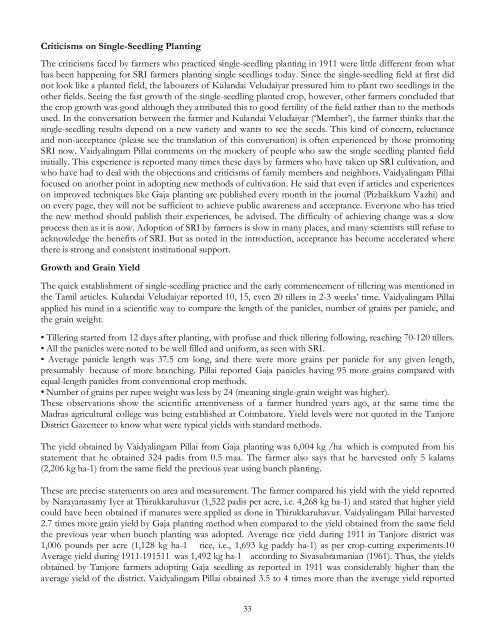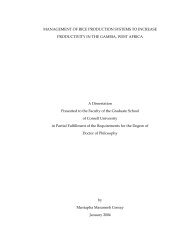Revised proceedings - The System of Rice Intensification - Cornell ...
Revised proceedings - The System of Rice Intensification - Cornell ...
Revised proceedings - The System of Rice Intensification - Cornell ...
You also want an ePaper? Increase the reach of your titles
YUMPU automatically turns print PDFs into web optimized ePapers that Google loves.
Criticisms on Single-Seedling Planting<br />
<strong>The</strong> criticisms faced by farmers who practiced single-seedling planting in 1911 were little different from what<br />
has been happening for SRI farmers planting single seedlings today. Since the single-seedling field at first did<br />
not look like a planted field, the labourers <strong>of</strong> Kulandai Veludaiyar pressured him to plant two seedlings in the<br />
other fields. Seeing the fast growth <strong>of</strong> the single-seedling planted crop, however, other farmers concluded that<br />
the crop growth was good although they attributed this to good fertility <strong>of</strong> the field rather than to the methods<br />
used. In the conversation between the farmer and Kulandai Veludaiyar („Member‟), the farmer thinks that the<br />
single-seedling results depend on a new variety and wants to see the seeds. This kind <strong>of</strong> concern, reluctance<br />
and non-acceptance (please see the translation <strong>of</strong> this conversation) is <strong>of</strong>ten experienced by those promoting<br />
SRI now. Vaidyalingam Pillai comments on the mockery <strong>of</strong> people who saw the single seedling planted field<br />
initially. This experience is reported many times these days by farmers who have taken up SRI cultivation, and<br />
who have had to deal with the objections and criticisms <strong>of</strong> family members and neighbors. Vaidyalingam Pillai<br />
focused on another point in adopting new methods <strong>of</strong> cultivation. He said that even if articles and experiences<br />
on improved techniques like Gaja planting are published every month in the journal (Pizhaikkum Vazhi) and<br />
on every page, they will not be sufficient to achieve public awareness and acceptance. Everyone who has tried<br />
the new method should publish their experiences, he advised. <strong>The</strong> difficulty <strong>of</strong> achieving change was a slow<br />
process then as it is now. Adoption <strong>of</strong> SRI by farmers is slow in many places, and many scientists still refuse to<br />
acknowledge the benefits <strong>of</strong> SRI. But as noted in the introduction, acceptance has become accelerated where<br />
there is strong and consistent institutional support.<br />
Growth and Grain Yield<br />
<strong>The</strong> quick establishment <strong>of</strong> single-seedling practice and the early commencement <strong>of</strong> tillering was mentioned in<br />
the Tamil articles. Kulandai Veludaiyar reported 10, 15, even 20 tillers in 2-3 weeks‟ time. Vaidyalingam Pillai<br />
applied his mind in a scientific way to compare the length <strong>of</strong> the panicles, number <strong>of</strong> grains per panicle, and<br />
the grain weight.<br />
• Tillering started from 12 days after planting, with pr<strong>of</strong>use and thick tillering following, reaching 70-120 tillers.<br />
• All the panicles were noted to be well filled and uniform, as seen with SRI.<br />
• Average panicle length was 37.5 cm long, and there were more grains per panicle for any given length,<br />
presumably because <strong>of</strong> more branching. Pillai reported Gaja panicles having 95 more grains compared with<br />
equal-length panicles from conventional crop methods.<br />
• Number <strong>of</strong> grains per rupee weight was less by 24 (meaning single-grain weight was higher).<br />
<strong>The</strong>se observations show the scientific attentiveness <strong>of</strong> a farmer hundred years ago, at the same time the<br />
Madras agricultural college was being established at Coimbatore. Yield levels were not quoted in the Tanjore<br />
District Gazetteer to know what were typical yields with standard methods.<br />
<strong>The</strong> yield obtained by Vaidyalingam Pillai from Gaja planting was 6,004 kg /ha which is computed from his<br />
statement that he obtained 324 padis from 0.5 maa. <strong>The</strong> farmer also says that he harvested only 5 kalams<br />
(2,206 kg ha-1) from the same field the previous year using bunch planting.<br />
<strong>The</strong>se are precise statements on area and measurement. <strong>The</strong> farmer compared his yield with the yield reported<br />
by Narayanasamy Iyer at Thirukkaruhavur (1,522 padis per acre, i.e. 4,268 kg ha-1) and stated that higher yield<br />
could have been obtained if manures were applied as done in Thirukkaruhavur. Vaidyalingam Pillai harvested<br />
2.7 times more grain yield by Gaja planting method when compared to the yield obtained from the same field<br />
the previous year when bunch planting was adopted. Average rice yield during 1911 in Tanjore district was<br />
1,006 pounds per acre (1,128 kg ha-1 rice, i.e., 1,693 kg paddy ha-1) as per crop-cutting experiments.10<br />
Average yield during 1911-191511 was 1,492 kg ha-1 according to Sivasubramanian (1961). Thus, the yields<br />
obtained by Tanjore farmers adopting Gaja seedling as reported in 1911 was considerably higher than the<br />
average yield <strong>of</strong> the district. Vaidyalingam Pillai obtained 3.5 to 4 times more than the average yield reported<br />
33

















